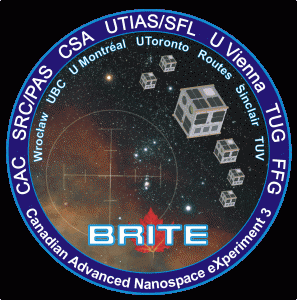By / par Gregg Wade (Canadian PI for BRITE)
(Cassiopeia – Autumn / l’automne 2019)
BRITE-Constellation is an international space astronomy mission consisting of a fleet of 20x20x20 cm nanosatellites dedicated to precision optical photometry of bright stars in two photometric colours. The mission continues in full science operations, with 38 data releases to BRITE target PIs having already taken place, and many datasets available in the public domain from the BRITE public archive.
The BRITE mission is a collaboration between Canadian, Austrian and Polish astronomers and space scientists. The Canadian partners represent University of Toronto, Université de Montréal, Bishop’s University, and Royal Military College of Canada. The mission was built, and the Canadian satellites operated, by the University of Toronto Institute for Aerospace Studies Space Flight Lab (UTIAS-SFL). The Canadian Space Agency funded the construction of the Canadian satellites, and continues to support their day-to-day operations.
Operations
There are five operating BRITE satellites in the Constellation, collecting data on various sky fields in a coordinated programme to obtain well-sampled, longterm continuous (~6 months) light curves in both red and blue bandpasses.
As this issue of Cassiopeia went to press, here was the status of the sky assignments for the BRITE nanosats:
- BRITE Toronto (Canada): Toronto observes with a red filter. It is currently observing the Cyg/Lyr II field. As implied by the numeral ‘II’, the current campaign on this field represents a revisit of a previously-observed field.
- BRITE Lem (Poland): Lem observes with a blue filter. It is also observing the Cyg/Lyr II field after successfully completing a campaign on the Sco II field.
- BRITE Heweliusz (Poland): Heweliusz observes with a red filter. This satellite was observing the Sco II field, but those observations were recently interrupted in order to observe a Target of Opportunity.
- BRITE Austria (Austria): BRITE Austria observes with a blue filter. It is observing the Sag V field.
- UniBRITE (Austria): UniBRITE observes with a red filter. This satellite is currently idle due to unresolved ACS stability issues.
The BRITE Constellation observing programme complete to mid-2020 has been planned by the BRITE Executive Science Team (BEST), and details are available on the BRITE photometry Wiki page.
Recent Science Results

Figure 1 – The left column illustrates the heartbeat model fit to BRITE photometry obtained by 3 different satellites. The right column illustrates the fit to the various epochs of radial velocity measurements. From Pablo et al. (2019).
« Epsilon Lupi: measuring the heartbeat of a doubly magnetic massive binary with BRITE Constellation » (Pablo et al. 2019, MNRAS 488, 64). Epsilon Lupi A is a binary system consisting of two main-sequence early B-type stars Aa and Ab in a short period, moderately eccentric orbit. The close binary pair is the only doubly magnetic massive binary currently known. Using photometric data from the BRITE Constellation we identify a modest heartbeat variation. Combining the photometry with radial velocities of both components we determine a full orbital solution including empirical masses and radii. These results are compared with stellar evolution models as well as interferometry and the differences discussed. We also find additional photometric variability at several frequencies, finding it unlikely these frequencies can be caused by tidally excited oscillations. We do, however, determine that these signals are consistent with gravity mode pulsations typical for slowly pulsating B stars. Finally we discuss how the evolution of this system will be affected by magnetism, determining that tidal interactions will still be dominant.
Conferences, Resources and Social Media
Conferences

Figure 2 – Conference photo from “Stars and their Variability, Observed from Space”.
The BRITE team recently organized an highly successful conference entitled “Stars and their Variability, Observed from Space”, to celebrate the anniversary of BRITE-Constellation in Vienna, Austria from August 19 – 23, 2019. Over 250 participants from 47 countries attended.
Resources
The BRITE Public Data Archive, based in Warsaw, Poland, at the Nikolaus Copernicus Astronomical Centre, can be accessed at brite.camk.edu.pl/pub/index.html.
The mission Wiki (including information on past, current and future fields) can be accessed at brite.craq-astro.ca/.
BRITE Constellation is on Facebook, at @briteconstellation.
The BRITE International Advisory Science Team
The BRITE International Advisory Science Team (BIAST), which consists of BRITE scientific PIs, technical authorities, amateur astronomers, and mission fans, advises the mission executive on scientific and outreach aspects of the mission. If you’re interested to join BIAST, contact Canadian BRITE PI Gregg Wade: wade-g@rmc.ca.










